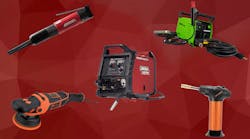When you think about welding tools, you might not automatically picture welding helmets or jackets, but these items are an important part of your arsenal. They protect you while you work and help you get the job done right. So whether it’s time to replace a worn-out jacket or you just need some ideas for your holiday wish list, here’s a look at the latest in welding wear.
High-tech helmets
Even novice welders know they need to protect their eyeballs from the bright lights of welding. Welding helmets come with varying levels of shade, and OSHA has some guidelines about how dark the shield ought to be. If you’re in the market for a new helmet, choosing one with an auto-darkening feature will make it easier to get started with your weld job and eliminate the flip-down head nod of traditional helmets. Look for helmets with multiple sensors to ensure they can pick up the light from the weld via a variety of angles.
There are lots of helmet options out there, with some manufacturers offering tweaks and improvements to give theirs an edge. For instance, 3M’s newest helmet, the Speedglas Auto-Darkening Filter Kit 9100XXi has improved optics that let the wearer see more natural color and contrast, improving weld puddle control. Plus you can go from welding to grinding by just touching a button. No need to waste time switching helmets.
The best in welding jackets
High-quality welding jackets provide full upper-body protection from welding sparks, and you’ll find them in a variety of styles. A few “upgrades” to look for here include:
- Satin lining that makes it easier to take the jacket off and on
- High-quality pigskin leather, which is lighter than other options
- Kevlar thread, which adds strength and durability to seams
Welding aprons come in a variety of materials as well. If you’d rather go this route than a jacket, make sure you get one that’s long enough to offer plenty of protection and plan to wear a shirt that shields your arms.
Welding glove extra
Material matters when it comes to welding gloves too. Thinner gloves will offer more flexibility but less protection. Thicker gloves are better for hotter welding, but can make it tricky to maneuver your torch and the pieces you’re working with. There’s an in-betweener option that addresses this issue. A finger heat shield is essentially a welding glove add-on that adds an extra layer of protection exactly where it’s needed. This option from Torch Wear can be used on any finger, and it’s made of their CarbonX material, which can protect your digits up to 2,500 degrees F.
What you wear when you weld is important. Those machines reach some seriously high temps, and it doesn’t take much to cause some real damage. Plus, you use it every day, so it makes sense to go with the best options available.
Source: Collisionology - Chief Automotive Technologies


